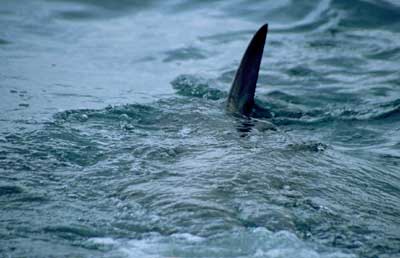
|
|
|
|
|
|
Shark Info (10-15-1999) |
Author |
|
Intro: |
Shark Info |
|
Main article: |
Dr. E. K. Ritter |
|
Article 1: |
Dr. J. F Morrisey |
|
Article 2: |
Shark Info |
|
Article 3: |
Shark Info |
|
Article 4: |
Shark Info |
|
Fact Sheet: |
Dr. E. K. Ritter |
|
Shark Behavior: Circling around alleged victims
The familiar image of a shark circling a swimmer or diver appears to have burned its way into many minds as being the foreboder of an attack. But does this famous scenario of a shark's dorsal fin cutting circles through the water really mean an impending attack? Fact or simply prejudice? It is prejudice. Sharks do not circle in the water before they attack, it is simply their way of trying to form an image of what they are confronting in the water. According to my own numerous observations this motion is a sign of pure curiosity and not an incentive to circle its prey and feed. Most shark species must engage in permanent swimming maneuvers to breathe for they cannot pump water past their gills to extract oxygen as other fish with skeletal systems can. In addition, a swimmer or diver, in contrast to a shark, remains almost immobile, so the shark can only choose between two available forms of behavior, circling or swimming a figure eight - moving up and down around the object of interest. Circling has the advantage that the shark need not continually change the direction of swimming while being able to remain at a constant distance to the object. However, when the object is not located in open waters, for example in a reef, the shark cannot circle without risking the loss of eye contact. In such case, the shark has to swim a figure eight around the swimmer or diver, and in so doing will make sure to always keep his back towards open water. Whatever the situation in the water may be, two things are decisively important for the shark: being able to observe and to flee. The nature of sharks is such that, like other predators, they always hold an escape route open - an easy strategy in open waters but more of a problem around reefs. Sharks may thus appear more nervous or excited in the vicinity of reefs in contrast to a similar situation in open water. If a shark observes an interesting object with his eyes, he may turn away and adjust his swimming motions to the object. The distance involved is sometimes defined as the shark's outer circle. In such a situation the eye is the primary sense, supported by the ear. The nose, in my opinion, may play a subordinate role or none at all, even if a scent may have been the primary factor to attract the shark in the first place. On the one hand, the shark is not always in the current when circling and thus cannot constantly receive odor molecules, on the other hand, eyes and ears are more accurate at short distances. Verringert sich die Distanz beim Kreisen noch weiter, kommt neben den Augen und dem Gehör noch ein weiteres Sinnesorgan zum Einsatz: das Wasserdruckorgan, das als Seitenlinienorgan bezeichnet wird. Entgegen älteren Beschreibungen wirkt dieses Organ nicht auf grössere Distanzen, wie es die Ohren für Schallwellen tun. Das Seitenlinienorgan ist jedoch auf kurze Distanzen, rund eine Körperlänge des Haies, äusserst empfindlich und präzise. If the distance to the object is reduced further when circling, another sensory organ starts
to come into play: the ampullae of Lorenzini or pressure measuring organ which may be
defined as a lateral line canal. In contrast to earlier descriptions of this organ - which
runs approximately the entire length of the shark - it does not function over greater
distances as ears do with sound waves, but is very precise and sensitive at short distances. If a shark picks up noises from a greater distance, or detects traces of a scent, such stimuli may possibly remind him of a jiggling fish or another familiar object. But if the shark moves closer into visual proximity, the image of a swimmer or diver usually does not match anything he has previously seen. At this point we should probably also question the theory of mistaken identity which usually makes the rounds in the media. That sharks mistake divers or surfers for seals is, in my opinion and that of other scientists, highly unlikely. Although it may look that way to humans, sharks have senses which over millions of years have adjusted perfectly to surviving and hunting in the water environment. Such careless mixups would be dangerous for sharks and thus highly unlikely. Whether the object is familiar or not, when a shark is attracted to certain signals from a distance and finds himself suddenly confronted with something really unknown - such as man - two perceptions prevail, curiosity and the drive to flee: The shark begins to circle. * Dr. Erich K. Ritter is a shark biologist, Senior Scientist at the Green Marine Institute und Adjunct Assistant Professor at Hofstra University, New York. May be published only by indicating the source: Shark Info / Dr. Erich K. Ritter |
|
|
|
|
|
|||||
